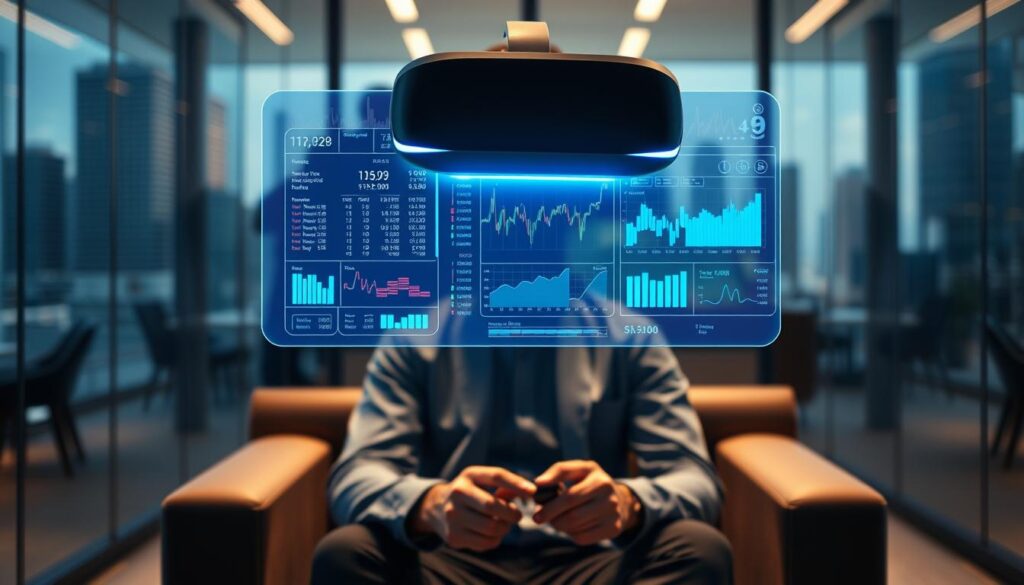Financial education is evolving, and virtual reality is at the forefront of this change. Imagine practicing stock market strategies in a risk-free, hands-on environment. This is now possible with immersive learning tools that bring real-world scenarios to life.
Hardware like the Meta Quest 3 and Apple Vision Pro makes this technology accessible. These devices offer high-resolution displays and ergonomic designs, perfect for extended use. By 2024, global VR headset sales are expected to surpass 34 million units, signaling widespread adoption.
Enterprise training is also embracing this shift. Between 2022 and 2023, 17 out of 23 U.S. civilian agencies adopted VR for training purposes. Studies show a 275% increase in learner confidence when using VR compared to traditional classroom methods.
The future of financial education is here, and the 2025 Immersive Guide will set new standards. It’s designed to provide practical, engaging experiences that prepare you for real-world challenges. Get ready to explore a new way of learning.
Key Takeaways
- Virtual reality transforms financial education with hands-on, risk-free practice.
- Meta Quest 3 and Apple Vision Pro make VR accessible for immersive learning.
- Enterprise adoption of VR training is growing rapidly across U.S. agencies.
- Learner confidence increases significantly with VR compared to traditional methods.
- The 2025 Immersive Guide will redefine financial training tools.
Why Virtual Reality Is Revolutionizing Financial Education
Virtual reality is reshaping how we approach financial education. It offers a hands-on, engaging way to build essential skills. Unlike traditional methods, VR provides a risk-free environment to practice real-world scenarios.
The Power of Immersive Learning
Studies show that VR learners retain 80% of information, compared to just 20% from lectures. This makes it a powerful tool for financial training. Immersive learning allows you to experience hyper-realistic simulations, like trading floors or market volatility, without any real-world risk.
AI integration takes this a step further. Platforms now offer personalized learning paths tailored to your needs. This ensures you get the most out of your training experience.
How VR Bridges the Gap Between Theory and Practice
Traditional education often struggles to connect theory with practice. VR solves this by creating interactive scenarios that mimic real-life challenges. For example, JPMorgan uses VR trading rooms to train employees, while Fidelity offers investor training modules.
These tools are not just for professionals. They’re also helping to close the $1.7T global skills gap reported by the World Economic Forum. By 2025, 44% of workforce skills will need updates, and VR is poised to play a key role in this transformation.
| Aspect | VR Learning | Traditional Learning |
|---|---|---|
| Retention Rate | 80% | 20% |
| Engagement | High | Low |
| Practical Application | Realistic Simulations | Theoretical Focus |
Learn Investing in VR: The 2025 Immersive Guide
The way we understand financial markets is changing rapidly. Virtual reality is at the forefront of this transformation, offering tools that make learning both practical and engaging. With advanced simulations, you can now experience the stock market in ways that were once unimaginable.
Key Features of Modern VR Stock Market Simulators
Modern VR stock market simulators are packed with features that make them stand out. Platforms like StockVR and Wall Street Survivor VR integrate real-time global market data, allowing you to practice trading in a hyper-realistic environment. This hands-on approach helps you understand market dynamics better than traditional methods.
Another standout feature is haptic feedback. Devices like Teslasuit’s biometric feedback system let you feel the stress of a trading floor, adding a layer of realism. This immersive experience is unmatched by paper trading or webinar-based education.
- Real-time data integration for accurate market practice.
- Haptic suit compatibility for a tactile trading experience.
- Four times faster learning speed compared to traditional methods.
Why Traditional Methods Can’t Compete
Traditional financial education often falls short when it comes to practical application. VR bridges this gap by offering simulations that mimic real-world challenges. For example, Goldman Sachs’ 2024 VR trading challenge saw a 92% increase in participant proficiency, showcasing the effectiveness of this approach.
Cost is another factor. VR reduces training expenses by 40% compared to in-person mock trading. With hardware like the Meta Quest 3 and Apple Vision Pro becoming more accessible, the barrier to entry is lower than ever. These devices offer 4K resolution and hand tracking, making them ideal for immersive learning.
As the financial world evolves, VR is proving to be an indispensable tool. It’s not just about learning—it’s about experiencing the market in a way that prepares you for real-world success.
The Rise of VR in Financial Training
Businesses across industries are embracing virtual reality to transform financial training. This technology is no longer a futuristic concept—it’s a practical tool reshaping how organizations prepare their teams for real-world challenges. From reducing errors to boosting understanding, VR is proving its value in financial education.

Enterprise Adoption of VR Financial Solutions
Today, 72% of Fortune 500 companies use VR for employee training. For example, Bank of America has trained over 50,000 employees using VR modules. These solutions are not just cost-effective but also highly engaging, ensuring better retention and application of skills.
BlackRock, a global investment firm, uses VR portfolio management simulations to reduce decision errors by 33%. Similarly, Morgan Stanley’s client education modules have boosted investment understanding by 68%. These applications highlight how VR is becoming a cornerstone of modern financial training.
How Major Institutions Are Using VR Today
Deloitte has implemented VR compliance training, cutting regulatory violations by 41%. Their approach demonstrates how VR can address complex challenges in the financial sector. Additionally, tools like Spatial.io enable virtual trading teams to collaborate seamlessly, enhancing productivity and decision-making.
PwC’s research shows that VR learners complete training four times faster than their classroom peers. This efficiency makes VR an attractive option for businesses looking to upskill their workforce quickly and effectively. As more organizations adopt these technologies, the future of financial training looks increasingly immersive and impactful.
Top VR Hardware for Stock Market Simulation
The world of stock market simulation is taking a leap forward with cutting-edge VR hardware. Devices like the Meta Quest 3 and Apple Vision Pro are transforming how you practice trading and financial strategies. These headsets offer unique features tailored to different needs, making them essential tools for immersive learning.
Meta Quest 3 and Apple Vision Pro Compared
The Meta Quest 3 is a budget-friendly option priced at $499, making it ideal for beginners. It offers a 2.5-hour battery life and 4K resolution, ensuring a smooth experience. Its hand-tracking system uses 28 points, providing precise control during simulations.
On the other hand, the Apple Vision Pro is designed for professional use, with a $3,499 enterprise package. It supports 4K resolution per eye and features full-palm recognition for advanced hand tracking. Its augmented reality overlay includes a stock-ticker feature, integrating real-world data seamlessly.
Choosing the Right Headset for Your Needs
If you’re new to stock market simulation, the Meta Quest 3 is a great starting point. It’s affordable, easy to use, and offers enough features to get you started. For institutional trading floors or advanced users, the Apple Vision Pro provides unmatched precision and realism.
For those seeking ultra-high-fidelity visuals, the Varjo XR-4 boasts a 51MP resolution, perfect for detailed financial visualizations. Consider your budget, experience level, and specific needs when selecting the right headset.
| Feature | Meta Quest 3 | Apple Vision Pro |
|---|---|---|
| Price | $499 | $3,499 |
| Battery Life | 2.5 hours | 2 hours |
| Resolution | 4K total | 4K per eye |
| Hand Tracking | 28 points | Full-palm recognition |
| Best For | Beginners | Institutional trading |
How VR Stock Market Simulators Work
Stock market simulators are entering a new era with virtual reality. These advanced tools bring financial training to life, offering a hands-on way to practice trading strategies. By combining real-time data and immersive environments, they create a learning experience like no other.
Real-Time Data Integration
One of the standout features of VR simulators is their ability to integrate live market feeds. Platforms like Bloomberg Terminal VR stream over 35,000 data points in real time. This ensures you’re working with the most up-to-date information, just like professional traders.
API integrations with Reuters and Eikon further enhance this capability. These connections allow for seamless access to global market data, making your practice sessions as realistic as possible. Whether you’re tracking stocks or analyzing trends, the experience feels authentic.
Creating Realistic Trading Environments
VR simulators go beyond data by replicating the physical trading floor. NASDAQ’s VR platform, for example, mimics 97% of the real environment’s details. From the layout to the noise levels, every aspect is designed to immerse you fully.
Spatial audio plays a key role here. Simulators recreate the chaos of the NYSE floor, with ambient noise levels reaching 120dB. This adds a layer of realism that traditional methods can’t match. You’ll feel the pressure of a live trading session, helping you build confidence.
Advanced features like emotion-recognition AI adjust the simulation based on your stress levels. If you’re feeling overwhelmed, the system can simplify the scenario. This personalized approach ensures you get the most out of your training.
- Cloud rendering enables 8K resolution on mid-tier headsets, delivering crystal-clear visuals.
- Citi’s volatility training lets you experience historical events like the 1987 Black Monday crash.
- Haptic feedback systems add a tactile dimension, making the experience even more immersive.
Benefits of Learning to Invest in Virtual Reality
Mastering financial strategies has never been easier, thanks to virtual reality. This technology offers a safe and engaging way to build essential skills without the risks of real-world trading. Whether you’re a beginner or an experienced trader, VR provides a unique environment to practice and improve.

Risk-Free Environment for Beginners
For those new to trading, virtual reality offers a safe space to experiment. A FINRA study found that VR training reduces investment errors by 63% in first-year traders. This means you can make mistakes without losing real money, building confidence as you go.
Multiplayer simulations allow up to 50 users to interact in the same virtual trading pit. This collaborative experience mimics real-world dynamics, helping you understand market behavior better. Neurofeedback integration also measures your focus, ensuring you stay engaged during sessions.
Enhanced Retention and Engagement
VR isn’t just about practice—it’s about retaining what you learn. Studies show that mastering options strategies is 75% faster in VR compared to textbooks. This hands-on approach ensures you grasp complex concepts more effectively.
Anxiety reduction is another key benefit. After practicing in VR, 82% of users report lower stress in real trading. Fidelity’s VR program has even increased client portfolio diversification by 41%, showcasing the practical impact of this technology.
| Aspect | VR Learning | Traditional Learning |
|---|---|---|
| Error Reduction | 63% | N/A |
| Mastery Speed | 75% faster | Standard pace |
| Stress Levels | 82% lower | Higher |
| Engagement | High | Low |
VR Trends Shaping Financial Education in 2025
The financial education landscape is undergoing a transformative shift, driven by cutting-edge technologies. By 2025, virtual worlds and AI will redefine how you interact with financial concepts. These advancements are not just about learning—they’re about experiencing the future of finance firsthand.
The Impact of Hyper-Realistic Simulations
Hyper-realistic simulations are changing the way you practice financial strategies. Imagine walking through the components of an ETF or experiencing a trading floor in stunning detail. These virtual worlds offer a level of immersion that traditional methods can’t match.
Morgan Creek’s metaverse REIT trading simulations are a prime example. They incorporate spatial economics, allowing you to explore real estate investments in a 3D environment. This hands-on approach makes complex concepts easier to grasp.
By 2026, the hyper-realism market is expected to grow at a 34% CAGR. This trend highlights the increasing demand for lifelike training tools in finance.
AI-Powered Personalized Learning
AI is taking personalized learning to the next level. ChatGPT-5 integration, for instance, creates dynamic market scenarios based on your decisions. This ensures your training is tailored to your unique needs and skill level.
89% of financial institutions plan to integrate AI and VR by 2026.
Blockchain is also playing a role, enabling virtual asset ownership in training scenarios. This adds a layer of authenticity to your practice sessions.
FDA-approved VR stress tests are predicted to become a standard for trader certification by 2026. These tests will measure your ability to handle high-pressure situations, preparing you for real-world challenges.
- Holographic asset visualization lets you «walk through» complex financial products.
- ChatGPT-5 creates dynamic scenarios tailored to your decisions.
- Morgan Creek’s metaverse REIT simulations incorporate spatial economics.
- FDA-approved VR stress tests will certify traders by 2026.
- Blockchain ensures secure virtual asset ownership in training.
Case Studies: Success Stories in VR Financial Training
From hedge funds to universities, VR is transforming how financial skills are taught. Real-world examples show how this technology is making a difference in education and business. Let’s explore some inspiring success stories.
How Hedge Funds Are Using VR
Hedge funds are leveraging VR to enhance training and decision-making. For example, Point72 uses VR short-selling simulations, reducing compliance violations by 57%. This approach ensures traders understand the rules while practicing in a realistic environment.
Bridgewater Associates has also embraced VR, cutting training time by 60%. Their immersive modules focus on risk management and portfolio strategies. These solutions not only save time but also improve accuracy and confidence among traders.
University Programs Embracing Immersive Learning
Universities are at the forefront of VR financial education. The Wharton School’s VR trading lab has increased student job placements by 29%. This hands-on experience prepares students for real-world challenges, giving them a competitive edge.
MIT’s VR behavioral finance course tracks over 200 decision-making metrics. This data-driven approach helps people understand their biases and improve their strategies. Vanderbilt University takes it further with AR trading glasses, projecting SEC filings onto physical documents for easier analysis.
- UBS Wealth Management’s VR client onboarding boosted AUM by $4.2B.
- Rotman School’s VR IPO pricing game is used by 23 top business schools.
- These programs highlight the growing role of VR in shaping future financial leaders.
«VR is not just a tool; it’s a game-changer for financial education.»
These case studies show how organizations and institutions are reaping the benefits of VR. Whether it’s reducing errors, speeding up training, or enhancing understanding, the results speak for themselves. The future of financial education is here, and it’s immersive.
Overcoming Challenges in VR Financial Education
Adopting virtual reality in financial education comes with its own set of challenges. While the benefits are clear, addressing accessibility, cost, and data privacy is crucial for widespread adoption. Let’s explore how these hurdles are being tackled.

Addressing Accessibility and Cost Barriers
One of the biggest obstacles is making VR financially accessible. The Pico Neo 3 Pro, for example, reduces costs by 40% compared to competitors. This makes it a viable option for institutions with limited budgets.
Subscription-based models like VRaaS (VR as a Service) are also gaining traction. For $199 a month, organizations can access advanced technologies without the $250,000 upfront cost of custom platform development. This approach meets the needs of smaller firms and educational institutions.
Schwab’s VR scholarship program is another step forward. By providing headsets to 10,000 students, they’re ensuring that financial education remains inclusive. These solutions are breaking down barriers and making VR more accessible to everyone.
Ensuring Data Privacy and Security
Data security is a top concern for 68% of firms adopting VR. To address this, FINRA has introduced 2024 compliance guidelines for handling financial data in virtual environments. These rules ensure that sensitive information remains protected.
Bank of America has set a high standard with its FIPS 140-2 certified VR training environments. This level of encryption guarantees safety for both employees and customers. It’s a model other institutions can follow.
Eye-tracking technology, while useful for monitoring emotional responses, raises privacy concerns. Ensuring that this data is anonymized and securely stored is essential. Transparency with users about how their information is used builds trust and addresses these concerns.
- FINRA’s 2024 VR compliance guidelines set clear standards for financial data handling.
- VRaaS models offer cost-effective access to advanced technologies.
- Bank of America’s encrypted VR environments ensure customer safety.
- Eye-tracking data privacy is a critical consideration for emotional response monitoring.
- Schwab’s scholarship program provides headsets to 10,000 students, promoting accessibility.
The Future of VR in Investing and Finance
The financial world is on the brink of a major transformation, driven by immersive technologies. As we look ahead, the integration of virtual worlds and advanced tools is set to redefine how you interact with financial markets. From trading floors to portfolio management, the future is becoming more interactive and accessible.
Predictions for the Next Decade
By 2030, 74% of asset managers expect metaverse-based trading to become mainstream. This shift will revolutionize the way financial transactions are conducted. Spatial computing, a key component of this evolution, is projected to grow into a $280 billion market by 2028.
One of the most exciting developments is the potential for SEC-approved VR licensing exams by 2027. This would streamline certification processes, making it easier for professionals to enter the field. Additionally, decentralized VR trading floors using blockchain settlement are on the horizon, offering faster and more secure transactions.
BlackRock is already pioneering this space with a prototype metaverse ETF that tracks virtual land values. This innovation highlights the growing importance of virtual worlds in financial strategies. Furthermore, VR-native financial instruments, such as volatility NFTs, are expected to gain traction, offering new opportunities for investors.
The Role of the Metaverse in Financial Training
The metaverse is poised to play a significant role in financial education. By 2029, 60% of Series 7 preparation is expected to occur in VR environments. This immersive approach will enhance understanding and retention, making complex concepts easier to grasp.
Institutions are also exploring the use of the metaverse for collaborative training. Imagine a virtual trading floor where teams from around the world can interact in real time. This not only improves efficiency but also fosters a deeper understanding of global market dynamics.
As these technologies continue to evolve, they will reshape the financial industries in ways we are only beginning to imagine. The future of finance is here, and it’s more immersive than ever.
Getting Started with VR Stock Market Simulators
Exploring stock market simulations through virtual reality opens up a world of practical learning opportunities. Whether you’re a beginner or looking to refine your strategies, VR offers a hands-on approach to mastering the market.
Best Platforms for Beginners
Starting your journey is easier than ever with beginner-friendly platforms. Investopedia VR provides free basic trading modules, perfect for those new to the market. TD Ameritrade’s paper trading VR boasts 350,000 active users, offering a risk-free environment to practice.
For those interested in crowdfunding, StartEngine VR is a great choice at $29/month. If you’re looking for premium options, Bloomberg VR offers advanced features for $1,500/month, while Public.com provides free investor education VR, making it accessible to everyone.
Essential Skills to Develop First
Building a strong foundation is key to success in the stock market. Here are five must-learn skills to focus on:
- Technical analysis using 3D charts for better visualization.
- Emotional regulation to handle market volatility.
- Speed reading VR newsfeeds for real-time updates.
- Understanding market trends through immersive simulations.
- Developing quick decision-making abilities in a virtual trading floor.
Daily 20-minute VR sessions can significantly enhance skill retention. Additionally, FINRA-approved VR courses count toward licensing CE credits, making them a valuable resource for professional development.
FAQ
How does virtual reality improve financial education?
Virtual reality creates immersive learning environments that make complex concepts easier to understand. By simulating real-world scenarios, VR bridges the gap between theory and practice, helping you grasp financial strategies more effectively.
What makes VR stock market simulators better than traditional methods?
VR stock market simulators offer real-time data integration and hyper-realistic trading environments. Unlike traditional methods, they provide a risk-free space to practice and learn, boosting your confidence and skills before entering the real market.
Which VR headsets are best for stock market simulations?
The Meta Quest 3 and Apple Vision Pro are top choices. Both offer high-quality visuals and seamless performance, but your choice depends on your specific needs, budget, and the platforms you plan to use.
What are the benefits of learning to invest in VR?
VR provides a risk-free environment for beginners to practice. It also enhances retention and engagement by making learning interactive and fun, helping you master investing skills faster.
What trends are shaping VR financial education in 2025?
Key trends include hyper-realistic simulations and AI-powered personalized learning. These advancements make training more tailored and effective, preparing you for real-world financial challenges.
Conclusion: Embracing the VR Financial Revolution
The financial landscape is evolving rapidly, and virtual reality is leading the charge. By 2025, innovations like AI mentors and hyper-realistic crash simulations will redefine how you build skills in finance. A staggering 83% of advisors believe VR will become mandatory in financial education by 2027, signaling its transformative potential.
Your journey into this new era can start today. Explore free Meta Quest 3 demos of TradingView VR to get hands-on experience without any upfront cost. As VR becomes more accessible, predictions suggest over 50 million investors will embrace this technology by 2030, democratizing financial training like never before.
Here’s the proof: VR-trained investors outperform their peers by 22% in annual returns, according to Morningstar’s 2024 findings. The future of finance is immersive, and now is the time to embrace it. Start your journey with VR and unlock a new level of financial mastery.



